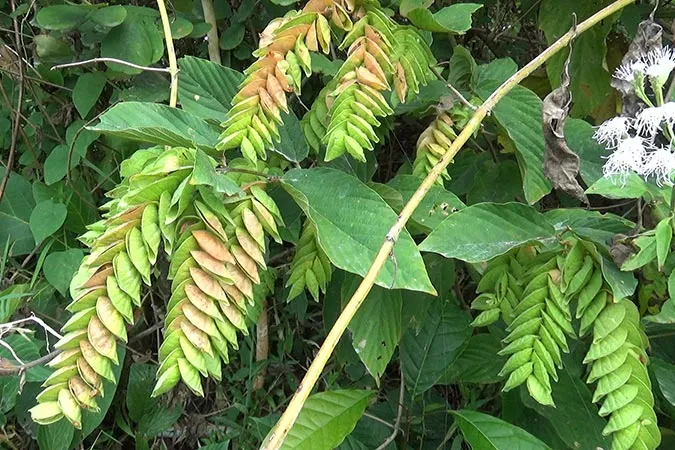Hahapan or wild hops (Flemingia strobilifera) is a plant species in Fabaceae, perennial flowering, shrubs that grow up to 1.5-2 m tall, woody stems, clustered, ovoid leaves to oblong, 6-15 cm long, 2.5-7 cm width, a bone in the middle with pinnate venation, wavy edges, and green.
F. strobilifera has small white bean-shaped flowers, covered by a pair of bracts, reniform, stemmed, arranged in 2 files along the raceme, like paper, corrugated like a shell, light green and finally turns thin to red when dry.
Small cylindrical pods release black and red seeds in an explosion. It grows wild in open areas and has a lot of sun or a little shade in secondary forests, road sides, slopes and abandoned land in the tropics. Widely used to treat epilepsy, hysteria and fever.
Kingdom: Plantae
Phylum: Tracheophyta
Subphylum: Angiospermae
Class: Magnoliopsida
Order: Fabales
Family: Fabaceae
Subfamily: Faboideae
Tribe: Phaseoleae
Subtribe: Cajaninae
Genus: Flemingia
Species: Flemingia strobilifera
F. strobilifera has small white bean-shaped flowers, covered by a pair of bracts, reniform, stemmed, arranged in 2 files along the raceme, like paper, corrugated like a shell, light green and finally turns thin to red when dry.
Small cylindrical pods release black and red seeds in an explosion. It grows wild in open areas and has a lot of sun or a little shade in secondary forests, road sides, slopes and abandoned land in the tropics. Widely used to treat epilepsy, hysteria and fever.
Kingdom: Plantae
Phylum: Tracheophyta
Subphylum: Angiospermae
Class: Magnoliopsida
Order: Fabales
Family: Fabaceae
Subfamily: Faboideae
Tribe: Phaseoleae
Subtribe: Cajaninae
Genus: Flemingia
Species: Flemingia strobilifera
